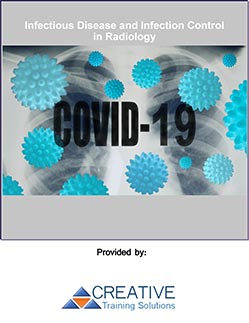Online Imaging / Radiology CE Courses

Infectious Disease and Infectious Control in Radiology
4 Continuing Ed Credits - Imaging/Radiology
$80.00
There is a broad range of infectious diseases that are communicable throughout the healthcare setting, including the department of radiology. Thousands of patients each year will undergo treatment for an infection, many of which are becoming resistant to antibiotic treatment. The U.S. Department of Health and Human Services reports that healthcare-associated infections or HAI’s affect approximately 1 in 25 patients who are admitted to a healthcare facility, leading to a significant financial and mortality burden.
Having a comprehensive understanding of not only the type of infections facing patients throughout the healthcare system but also how pathogens are spread and how to reduce the risk of transmission in the clinical and hospital setting is imperative for radiology care professionals.
Learning Objectives
After studying the information presented, the reader should be able to:
- Discuss vital infectious disease statistics
- Define the major terms associated with infectious diseases and infection control
- Discuss and describe the annual economic impact of infectious diseases in the healthcare setting
- Understand and discuss the types of infectious diseases
- Describe drug resistance
- Discuss the inappropriate use of antibiotics and its effect on infections
- Differentiate between gram positive versus gram negative bacteria
- List gram-positive and gram-negative bacteria
- Describe the characteristics of hospitalized patients that contribute to transmission of infectious diseases
- Define the guidelines for effective hand-hygiene in healthcare settings+
- Describe types of isolation precautions
- Discuss how to prevent infectious diseases in radiology
- Discuss how to properly transport a patient within the healthcare facility
- Understand and discuss aseptic technique in interventional radiology
